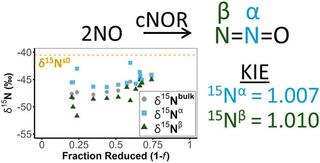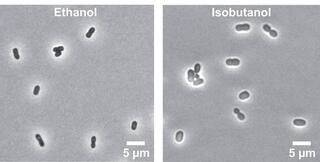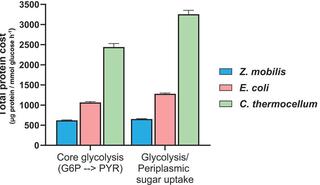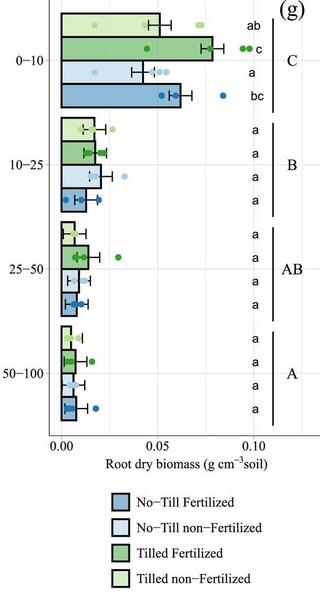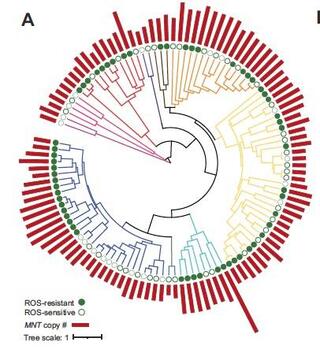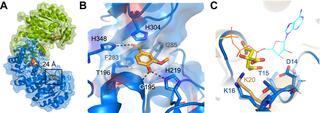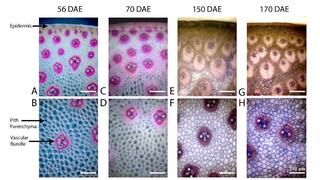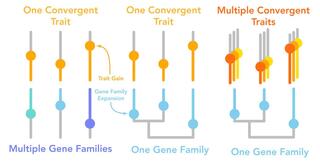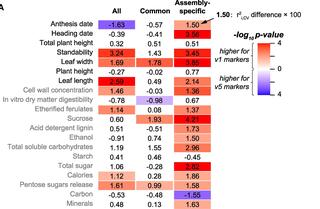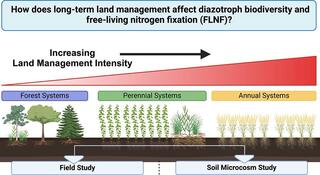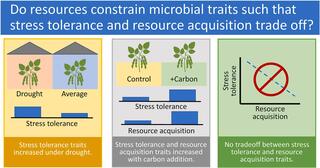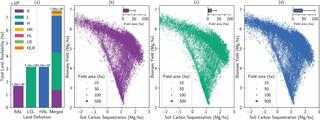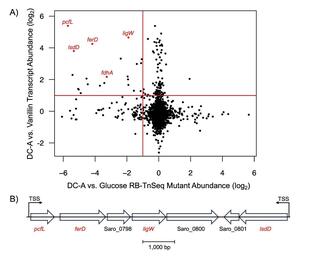GLBRC Data Sets
Highlighted below are a variety of published studies that include data sets that might be of interest to the scientific community and have been deposited in online data repositories. Only data sets published in GLBRC-approved repositories following the FAIR Guiding Principles are highlighted. More information can be found on our guidelines page.
GLBRC Sustainability Data Catalog
This Data Catalog is a collection of data from GLBRC's Sustainability research carried out in Michigan and Wisconsin. The Data Catalog summarizes each data table in order to allow the GLBRC community to better understand the data that have been collected and encourage collaboration.
Draft genome of the switchgrass head smut pathogen Tilletia maclaganii
Tilletia maclaganii is a smut fungal pathogen that causes significant biomass reduction of switchgrass (Panicum virgatum) used for animal forage and biofuel production. Here we present the annotated genome of T. maclaganii, strain Tm001-NY21, estimated at 42.79 Mb in size, in 53 assembled contigs and encoding 10,235 predicted genes.
Isoptopic fractionation and kinetic isotope effects of a purified bacterial nitric oxide reductase (NOR)
Nitrous oxide (N2O) is a serious concern due to its role in global warming and ozone destruction. Agricultural practices account for ∼80% of all anthropogenic N2O produced in the US, due in large part to the stimulation of microbial denitrification.
Physiological and metabolic responses of Zymomonas mobilis to lignocellulosic hydrolysate
Zymomonas mobilis is a promising biocatalyst for the sustainable conversion of lignocellulosic sugars into biofuels and bioproducts, yet its response to lignocellulosic hydrolysates remains poorly understood. Here, we investigate the physiological response of Z.
Thermodynamics shapes the in vivo enzyme burden on glycolytic pathways
Thermodynamically constrained reactions and pathways are hypothesized to impose greater protein demands on cells, requiring higher enzyme amounts to sustain a given flux compared to those with stronger thermodynamics.
Agricultural management legacy effects on switchgrass growth and soil carbon gains
Switchgrass (Panicum virgatum L.) is a native North American grass currently considered a high-potential bioenergy feedstock crop. However, previous reports questioned its effectiveness in generating soil organic carbon (SOC) gains, with resultant uncertainty regarding the monoculture switchgrass's impact on the environmental sustainability of bioenergy agriculture.
Machine learning reveals genes impacting oxidative stress resistance across yeasts
Reactive oxygen species (ROS) are highly reactive molecules encountered by yeasts during routine metabolism and during interactions with other organisms, including host infection.
MarK, a Novosphingobium aromaticivorans kinase required for catabolism of multiple aromatic monomers
The aromatic compounds used in a variety of industrial products are currently obtained from nonrenewable petroleum sources. Alternatively, the plant polymer lignin is an abundant renewable source of aromatics, and its depolymerization generates a variety of products that can include acetovanillone, a vanillin derivative containing an acetyl side chain.
Bioenergy sorghum stem density increases threefold following internode elongation due to continued accumulation of lignified cell walls and complex regulation of genes involved in cell wall biosynthesis
Bioenergy sorghum is a highly productive drought tolerant C4 grass that accumulates ~ 80% of its harvested biomass in ~ 4 m long stems comprised of > 40 internodes that develop sequentially during an extended vegetative growth phase.
Local adaptation of both plant and pathogen: an arms-race compromise in switchgrass rust
In coevolving species, parasites locally adapt to host populations as hosts locally adapt to resist parasites. Parasites often outpace host local adaptation since they have rapid life cycles, but host diversity, the strength of selection, and external environmental influence can result in complex outcomes.
Transcriptomic data sets for Novosphingobium aromaticivorans DSM12444 and a ΔSARO_RS14285 mutant grown in the presence of glucose and either protocatechuic, vanillic, syringic, or 4-coumaric acid
The SARO_RS14285 gene, encoding a transcription factor, was deleted in Novosphingobium aromaticivorans DSM12444. The transcriptomes of the parent and ΔSARO_RS14285 strains were determined when grown in medium containing glucose with or without protocatechuic, vanillic, syringic, or 4-coumaric acid. We present the raw RNA sequencing data obtained from these cultures.
Using DNA affinity purification sequencing (DAP-seq) to identify in vitro binding sites of potential Novosphingobium aromaticivorans DSM12444 transcription factors
Genome-wide binding sites of 44 putative transcription factors (TFs) from Novosphingobium aromaticivorans DSM12444 were analyzed using DNA affinity purification sequencing. We report that 32 of these TFs have at least one area of enrichment. These data will help better understand aromatic metabolism and other features of N. aromaticivorans biology.
Convergent expansions of keystone gene families drive metabolic innovation in Saccharomycotina yeasts
Many remarkable phenotypes have repeatedly occurred across vast evolutionary distances. When convergent traits emerge on the tree of life, they are sometimes driven by the same underlying gene families, while other times, many different gene families are involved. Conversely, a gene family may be repeatedly recruited for a single trait or many different traits.
Optimizing genomic prediction for complex traits via investigating multiple factors in switchgrass
Genomic prediction has accelerated breeding processes and provided mechanistic insights into the genetic bases of complex traits.
Reduced soil diazotroph diversity decreases nitrogen fixation rates but depends on land management
Soil diazotrophs convert atmospheric nitrogen into plant-available ammonium through free-living nitrogen fixation (FLNF). This sustainable nitrogen source can reduce our dependence on synthetic fertilizer inputs in conventional agricultural systems.
Drought increases microbial allocation to stress tolerance but with few tradeoffs among community-level traits
Climate change will increase soil drying, altering microbial communities via increasing water stress and decreasing resource availability. The responses of these microbial communities to changing environments could be governed by physiological tradeoffs between high yield, resource acquisition, and stress tolerance (YAS framework).
Available land for cellulosic biofuel production: a supply chain centered comparison
The land that is potentially available to produce dedicated cellulosic bioenergy crops, often referred to as ‘marginal’ land, depends heavily on the underlying assumptions used to classify and identify it.
RB-TnSeq barcode abundance data sets for Novosphingobium aromaticivorans grown on the β-5-linked aromatic dimer dehydrodiconiferyl alcohol
A randomly barcoded transposon insertion sequencing (RB-TnSeq) library of Novosphingobium aromaticivorans DSM12444 was grown in media containing either glucose or the beta-5-linked aromatic dimer dehydrodiconiferyl alcohol (DC-A) as the sole carbon source. The cultures were grown to saturation and then sequenced, yielding the barcode abundance data sets presented here.
Highly multiplexed design of an allosteric transcription factor to sense new ligands
Allosteric transcription factors (aTF) regulate gene expression through conformational changes induced by small molecule binding. Although widely used as biosensors, aTFs have proven challenging to design for detecting new molecules because mutation of ligand-binding residues often disrupts allostery.
Effects of acid dissociation and ionic solutions on the aggregation of 2-pyrone-4,6-dicarboxylic acid
The conversion of lignin can produce biomass-derived aromatic compounds such as 2-pyrone-4,6-dicarboxylic acid (PDC), which is a potential sustainable precursor of bioplastics. PDC is a pseudoaromatic dicarboxylic acid that can aggregate in aqueous solution.

